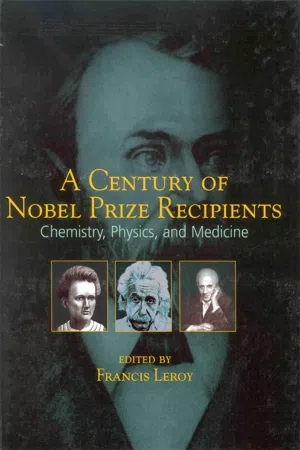
This is a test
- 300 pages
- English
- ePUB (mobile friendly)
- Available on iOS & Android
eBook - ePub
Book details
Book preview
Table of contents
Citations
About This Book
Celebrating a century of revolutionary contributions to our understanding of life, the world, and the universe, this encyclopedic desk reference traces the discoveries that earned nearly 500 distinguished scientists Nobel honors in the areas of chemistry, physics, and medicine. The School of Library Journal called it "...eye-catching... Original ar
Frequently asked questions
At the moment all of our mobile-responsive ePub books are available to download via the app. Most of our PDFs are also available to download and we're working on making the final remaining ones downloadable now. Learn more here.
Both plans give you full access to the library and all of Perlego’s features. The only differences are the price and subscription period: With the annual plan you’ll save around 30% compared to 12 months on the monthly plan.
We are an online textbook subscription service, where you can get access to an entire online library for less than the price of a single book per month. With over 1 million books across 1000+ topics, we’ve got you covered! Learn more here.
Look out for the read-aloud symbol on your next book to see if you can listen to it. The read-aloud tool reads text aloud for you, highlighting the text as it is being read. You can pause it, speed it up and slow it down. Learn more here.
Yes, you can access A Century of Nobel Prize Recipients by Francis Leroy in PDF and/or ePUB format, as well as other popular books in Medicine & Medical Theory, Practice & Reference. We have over one million books available in our catalogue for you to explore.
Information
The Nobel Laureates in Medicine (1901-2001)
Francis Leroy
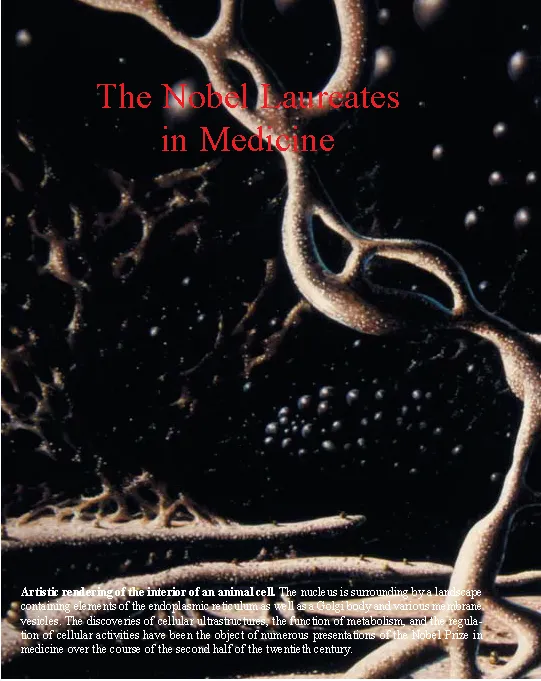
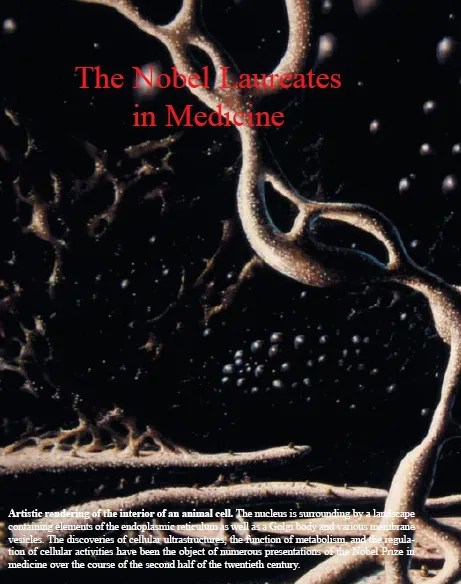
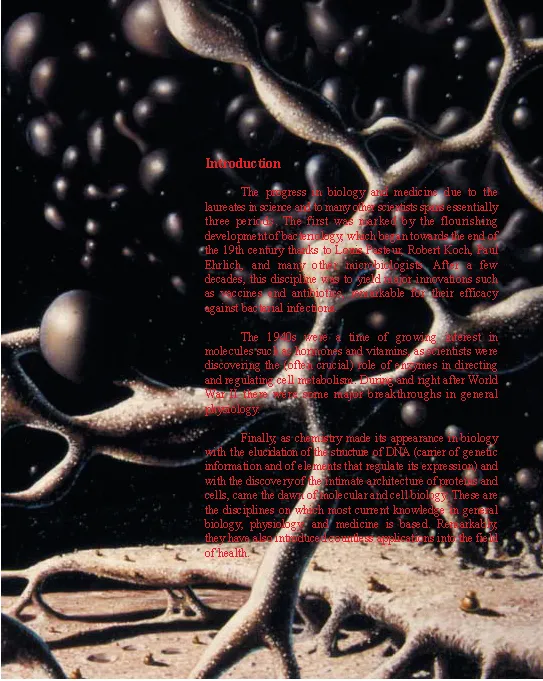

A colony of staphylococci.Pathogens and the illnesses they cause have been a major subject of medical research since the work of Louis Pasteur.
1901
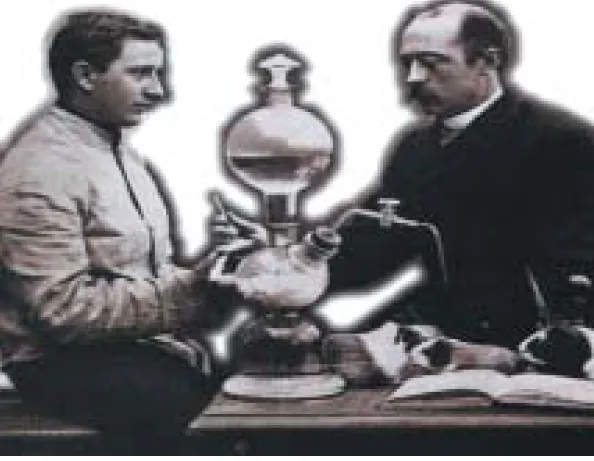
A. von Behring and one of his students
Behring, Emil Adolf von (Hansdorf, West Prussia, March 15, 1854-Marburg, Germany, March 31, 1917). German physician and microbiologist. Nobel Prize for Medicine for his work on serum therapy, especially its application against diphtheria. Emil von Behring came from the family of a schoolmaster. He was the eldest of 13 children. He began his studies in the field of microbiology at a time when scientists were enthusiastically pursuing research in this new area because of the realization that many diseases were of bacterial origin. Behring started out as an assistant of Robert Koch and he is associated with the demonstration that the blood of an infected individual contained antitoxins capable of neutralizing bacterial toxins. These studies were conducted along with the Japanese researcher Shibasaburo Kitasato, who was a member of Koch's team. One of their first important successes was the development of a serum for the treatment of diphtheria, a paralysing respiratory disease responsible for many infant deaths at the time. The first anti-diphtheria vaccine was successfully tested out on a sick child on Christmas night 1891. The work of Behring and his co-workers led the way for serotherapy as well as the development of more efficient diptheria vaccines later by Paul Erlich, another colleague of Koch. In 1895 Adolf von Behring became Professor at the University of Marburg. He was interested in combatting tuberculosis and, along with his co-workers, contributed to the successful immunisation of cattle against this disease.
1902
Ross, Sir Ronald (Almora, India, May 13, 1857-London, England, September 16, 1932). British physician. Nobel Prize for Medicine for his work on malaria. Had he followed his inclination, Ronald Ross could just as well have been a painter, poet, or mathematician, but the irrevocable decision of his father, an English officer in the
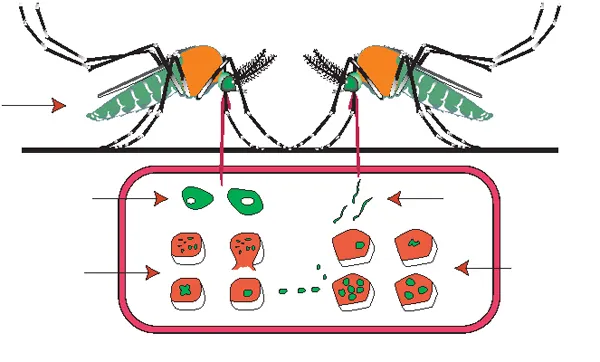
The life cycle of the malaria parasite Plasmodium. Plasmodium's gametocysts produced during the sexual phase of the parasite are picked up when a mosquito bites an infected person. Sporozoites are produced and migrate to the salivary gland of the insect. Finally, the infected mosquito injects sporozoites into a healthy person via the skin.
Indian Army, led him to undertake medical studies. Once they were over, however, he wrote no less than 15 literary works and an algebra treatise. Yet Ross's name remains associated with the confirmation that the vector of the haematozoan responsible for malaria in man is a mosquito. Sir Patrick Manson was the one to suggest this, but Ross practically proved it by discovering the plasmodium in the bodies of mosquitoes that had fed on the blood of people suffering from malaria. He then identified the parasite that causes malaria in birds, in the saliva glands of C. fatigans, the mosquito vector for this group of animals. Later it was shown that the plasmodium's reproductive cycle includes a stage in the salivary glands of the dipteran, and that the latter transmits the parasite to a healthy bird through a bite. The intervention of mosquitoes as vectors of human malaria was also confirmed, by an Italian team headed by Giovanni Battista Grassi. The discovery that a mosquito could carry an infectious germ was new at the start of the 19th century, even though this had already been mentioned by the Cuban biologist Carlos J. Finlay as early as 1881. Finlay's observation that a dipte-ran was the vector of yellow fever failed to attract the attention of his fellow scientists, and his results were not confirmed until years later by an American commission meeting in Cuba. He became Vice-President from 1911 to 1913. Ronald Ross was knighted in 1911.
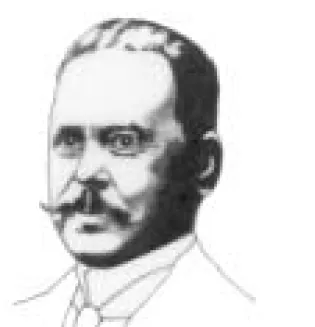
Ronald Ross
1903
Finsen, Niels Rydberg (Thorshavn, Denmark, December 15, 1860-Copenhagen, Denmark, September 24, 1904). Danish physician. Son of a civil servant. Nobel Prize for Medicine for the application of light in the treatment of skin diseases. Thanks to Finsen's discovery, it was shown that ultraviolet radiations have a bactericidal effect. The use of ultraviolet light proved to be effective in treating lupus vulgaris, a disfiguring skin disease caused by bacteria. Although this light therapy was not recommended ulteriorly, the Nobel Committee decided to reward this researcher in 1903. Some applications of ultraviolet radiation have proved very useful: it is used to induce mutations experimentally and to kill bacteria in hospitals and research laboratories. Niels Rydberg Finsen received his Ph.D. in medicine from the University of Copenhagen in 1890.
1904
Pavlov, Ivan Petrovich (Ryazan, Russia, September 26, 1849-Leningrad, Soviet Union, February 27, 1936). Russian physiologist. He was awarded the Nobel Prize for Medicine for research on digestion and on the conditioned reflex. In 1891, Ivan Pavlov became Director of Physiology in the St. Petersburg Institute for Experimental Medicine. Having first been noticed by the scientific community for major work on food digestion, he then focused on the neural aspects of this function. He notably showed that the mere sight of food, with the subsequent emission of neuronal signals from the brain to the organs concerned, is sufficient to trigger secretion of gastric juices. Ivan Pavlov then showed how a signal not related to food could make a dog salivate, once it had been associated with the initial signal. Every time he offered food to a group of experimental dogs, he also rang a bell. The dogs soon learned to associate the sound of the bell with food. After a sufficient number of repetitions, Pavlov showed that the dogs would secrete saliva in response to the bell alone; the taste, sight, smell of food was no longer necessary. The Russian scientist thus demonstrated scientifically the existence of so-called "conditioned reflexes", actually already known to animal trainers. This type of associative learning became the basis of major works in experimental psychology and gave rise to the idea that several human behaviours could be conditioned. From this type of experiment Pavlov concluded that "reflex activity of the brain adapts a living organism to its environment through the creation of new nerve connections, and species evolution transforms certain acquired reflexes into innate reflexes". For this scientist, the link between psychic activity and the brain was paramount. He even wondered whether it might be possible to detect an elementary manifestation of the psyche that could be considered purely physiological. According to him, such a discovery would have made possible the development of scientifically rigorous and objective studies on the conditions of appearance of the psyche. Furthermore, the fact that training programs based on the principles of conditioning animals to learn quite complicated behavioral routines quickly suggested that the phenomenon might also account for the complex patterns of behavior found in man. Indeed Pavlovian conditioning became an extremely influential school of thought in the study of animal behavior. In addition, they led to the elaboration of hypotheses suggesting that several forms of human behaviour could be conditioned. His open criticism of communism did not prevent him from keeping his job, and Pavlovian psychology remained very popular in the Soviet Union.

Ivan P. Pavlov
1905
Koch, Robert (Klausthal, Germany, December 11, 1843-Baden-Baden, Germany, May 27,1910). German microbiologist and physician. Son of a mining engineer. Nobel Prize for Medicine " for his discoveries in the field of tuberculosis". Koch is considered as the greatest of all pure bacteriologists. Robert Koch received his medical education from the University of Göttingen in 1862. After earning his medical degree in 1866, he moved to the University of Berlin where he studied chemistry. From 1872 to 1880, he worked in Wollstein, a small town in Polish Prussia, as a humble practitioner without any contacts with the academic world. Yet his work led to the development of techniques enabling him to isolate the anthrax bacillus that could be seen in the blood of infected cats. Later, after being appointed to a position in Berlin, he developed a rigorous method for creating gelatine-based-and later agar-based culture media, combined with the use of aniline dyes and favourable to the growth of bacterial colonies. These techniques revolutionized bacteriology. Yet Koch is famous above all for having isolated the bacterium that causes tuberculosis in humans. In the second half of the 19th century, this disease was the cause of nearly one-seventh of all deaths. His failure to treat the disease or to vaccinate against it with tuberculin-a sterile liquid containing a concentrate of dead tuberculosis bacilli-was offset by the great utility of tuberculin in detecting patients who had been previously exposed to the disease. This is the famous tuberculin test. Koch's growing reputation brought him into competition with another giant in bacteriology: the French scientist Pasteur. They carried this rivalry to Egypt, where Koch's team and a French one led by Roux both attempted to discover the cause of cholera. Koch was the one to demonstrate the link between the disease and a bacillus. He correctly concluded that cholera is caused by a bacterium, which he succeeded in isolating and growing. This remarkable scientist was also a great traveller. During his trips to South and West Africa, as well as to India and Indonesia, he carried out research and published many papers on illnesses such as bubonic plague, malaria and sleeping sickness, which at one time were widespread.

A dividing bacteria. Note the punching in of the cell wall between the two newly formed daughter cells.

Gram-negative bacteria. Their wall are thin but complex, having a lipopolysaccharide layer outside it. These bacteria are resistant to the lytic action of lysozyme.

Robert Koch
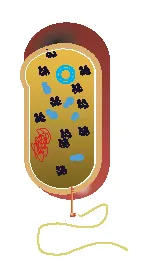
Bacterium. A three-...
Table of contents
- Cover Page
- Title Page
- Copyright Page
- Preface
- The Nobel Laureates in Chemistry (1901 - 2001)
- The Nobel Laureates in Physics (1901 - 2001)
- The Nobel Laureates in Medicine (1901 - 2001)
- Table: The Nobel Prize Laureates (1901-2001)